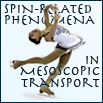Speaker
Irina Yakimenko
Description
The physics of low-dimensional semiconductor structures such
as quantum wires (QW) and quantum point contacts (QPCs) has
developed into an important part of nanotechnology,
specially in connection with spintronics and quantum
information. In our current studies we focus on electronic
states, effects of electron interactions and conductance
anomalies in semiconductor quantum point contacts and wires
with different geometries to a model GaAs/AlGaAs device [1].
Using the local spin density approximation (LSDA) we recover
spin-polarized states in the middle of a conventional QPC
results in the 0.7 (2e2/h) conductance anomaly as well as
spin-split states near the two edges of the QPC that may be
associated with the conductance anomaly in the vicinity of
0.25 (2e2/h). Effects of spontaneous magnetization might be
also used for spintronics applications such as spin filters
and all-electric QPC spin-polarizer. These systems are
physically rich and constantly bring new experimental data
such as the unusual conductance behavior in the case of
shallow confinement potential in a low electron density
regime, the anomalous properties of the 2DEG around the
pinch-off regime and the formation of bound states with
Kondo physics involved. This leads to the study of ballistic
transport in low-dimensional semiconductor-based
nanostructures in the ultralow electron density domain where
the interaction-induced localization of electrons takes
place. By means of LSDA we have shown that the localization
of electrons within the barrier embedded in the wire and
that the localization is highly dependent on the sharpness
and length of the potential barrier. For a shallow
barrier-free wire we retraced the structural transitions at
low densities from a single chain of localized states to
double and triple chains (Wigner spin lattices). We have
found that the double chain appears as a double zig-zag
configuration [2]. Localized electrons may have interesting
applications for semiconductor nanodevices. Indeed the
formation of bound state and spin binding within QPC
confinement potential opens possibilities to store
information and to realize qubits in quantum circuits. We
have studied the electron transport in a quantum wire in the
presence of bias between source and drain [3]. Our work has
confirmed that spontaneous spin splitting does occur within
the wire and it is responsible for both the 0.25 and 0.85
plateaus. We have also shown that the 0.25 plateau consists
of two regions, one that is spin polarized, and another that
is degenerate with a conductance that remains essentially
the same at both sides of the transition. This result is of
potential interest for semiconductor spintronics since it
opens a new possibility for spin manipulation by an electric
field.
[1] K.-F. Berggren and I. I. Yakimenko. J. Phys.: Condens. Matter 20, 164203 (2008).
[2] E. Welander, K.-F. Berggren, I. I. Yakimenko. Phys. Rev. B 82, 073307 (2010).
[3] H. Lind, I. I. Yakimenko, K.-F. Berggren. Phys. Rev. B 83, 075308 (2011).
[1] K.-F. Berggren and I. I. Yakimenko. J. Phys.: Condens. Matter 20, 164203 (2008).
[2] E. Welander, K.-F. Berggren, I. I. Yakimenko. Phys. Rev. B 82, 073307 (2010).
[3] H. Lind, I. I. Yakimenko, K.-F. Berggren. Phys. Rev. B 83, 075308 (2011).

